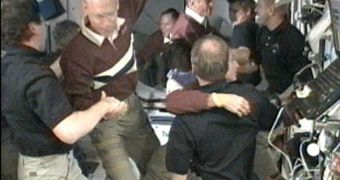After two days of following the International Space Station (ISS) in orbit, space shuttle Discovery finally caught up with the outpost and docked on it at 8:54 pm EDT (0054 GMT, August 31), on Saturday. The hatch connecting the two spacecraft was opened just 90 minutes later, and the number of astronauts on the space lab again jumped to 13. NASA astronaut Nicole Smith handed the Soyuz slip seat to ISS flight engineer Timothy Kopra, essentially taking his place in the Expedition 20 crew. Kopra will return home aboard the next Soyuz flight, scheduled for mid-September, Space reports.
Earlier on Saturday, the STS-128 mission crew inspected the heat shield on the shuttle, as it was trailing behind the ISS. The check was carried with the usual sensor-laden pole, which swapped the ceramic tiles making up the thermal defense. Discovery's underbelly and wings were looked at, and preliminary results show the craft to be in good health, according to the crew and mission controllers. The photos sent back to the Mission Control will, naturally, be thoroughly analyzed, but the initial results are encouraging, space agency officials say.
For the docking procedure, pilot Kevin A. Ford could not rely on the shuttle's six small engines, which are regularly used extensively during approach and docking procedures. He rather used the large thrusters, in a series of maneuvers that kept everyone in suspense. “He just flew it like a champ today,” Tony Ceccacci, who is the shuttle flight director, told reporters after the successful docking. One of the smaller motors showed a leak, and the astronauts did not want to jeopardize the mission in making the malfunction worse by using only the others.
Discovery ferried eight tons of equipment to the football field-sized ISS, including food, water, oxygen and scientific equipment. The Combined Operational Load Bearing External Resistance Treadmill (COLBERT) was also delivered, so that astronauts could work out their muscles and bones, while subjected to the unforgiving effects of microgravity. The shuttle's mission is scheduled to last for 13 days, with three spacewalks planned during this time. The first is scheduled for 21:49 UTC, on September 1st.

 14 DAY TRIAL //
14 DAY TRIAL //